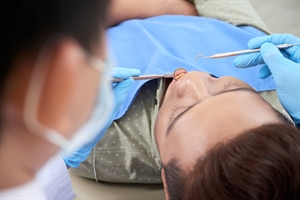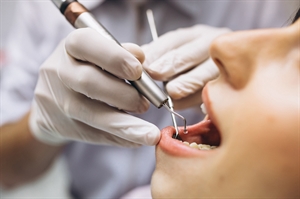All Categories
Featured
Table of Contents
In Buckeye, AZ, Lina Hester and Destinee Conley Learned About Places To Visit In Frederick Md
What Is Basic Dental Care? What is preventive dental care and how does it differ from routine cleaning? While both practices can help to keep your teeth and gums in good health, they have distinct purposes. When you are younger, your teeth can be very delicate so proper oral hygiene is essential. This means that you should brush and floss every day. It is also a good idea to visit your dentist at least once a year for checkups and cleanings. Your dentist will be able to take a look at your teeth and tell you what they think needs to be done. The first step in proper teeth cleaning and maintenance is a professional cleaning. It is important to note that cleaning is not always performed by a dentist. Some other factors that might require a professional cleaning include root canal treatments, fillings, crowns and dental implants. If a dentist performs the cleaning on an individual's own, it may be very difficult to maintain the quality of that individual's teeth and gums. The dentist will use an instrument known as a dental trying to clean the teeth and gums. There are other types of problems as well such as tooth decay and gum disease. Gum disease can result in gingivitis. If you have gingivitis and you neglect your teeth, it can cause gum disease. It is important to see your dentist on a regular basis for these types of problems. When visiting a dentist's office for this type of procedure, the patient is advised to follow the doctor's recommendation regarding how often he or she should clean their teeth and gums. Some professionals believe the best way to maintain proper dental hygiene is through daily brushing, while others prefer to practice twice or three times a day. In general, dental diseases affect people of all ages. Teeth may wear out faster during the first few years of life, as a result of tooth decay. However, teeth may also wear out more quickly due to the effects of gravity, resulting in cavities and gum disease. Dental problems may be more likely to occur if you smoke, drink coffee or tea, or have diabetes or heart disease. Dental care is not expensive. If you have problems, you should consult with a local dentist to determine what steps will need to be taken to correct the problem. When you visit the dentist, he or she will evaluate the problem and tell you what you can expect from a visit to the dental clinic. Dental hygienists perform the actual cleaning process when the patient enters the dentist's office and performs their oral care. They are trained in using the equipment and the dentist cleans the teeth and removes plaque and bacteria from the teeth. Many dental clinics also offer mouthwash and other types of dental products. Mouthwash is commonly used for those who have sore gums or cracked or chipped teeth. Bacteria can build up and can cause tooth decay. This will lead to gum disease, if your dentist does not remove the bacteria from the teeth. If you do not brush your teeth often enough or do not brush at all, your teeth can get covered with bacteria. The teeth are very delicate and require regular cleaning to prevent tooth decay. The dentist will usually clean the teeth between professional visits. Some common practices include using a root canal to treat cavity problems and maintaining the overall health of the teeth and gums. The dentist may also recommend braces to help strengthen the teeth. Dental clinics use a variety of different methods to treat these problems. Most clinics offer dental procedures, including cleaning, scaling and filling. You will probably have your teeth cleaned by a professional dentist to remove the bacteria and plaque from the teeth. Tooth grinding, which is a common cause of cavities, may require root canal treatment. You will need to visit a dentist to determine what steps need to be taken to prevent tooth loss. If tooth grinding is a result of tooth decay, your dentist may prescribe antibiotics and other medications to help with the problem.
City in Maryland, United StatesFrederick, MarylandCity of FrederickBridge on Carroll CreekMotto( s): "The City of Clustered Spires" Place within the State of MarylandShow map of MarylandFrederick (the United States) Program map of the United StatesCoordinates: Coordinates: United States Founded1745Government MayorMichael O'Connor (D-MD) Board of AldermenKelly Russell (D-MD) Ben MacShane (D-MD) Derek Shackleford (D-MD) Donna Kuzemchak (D-MD) Roger Wilson (D-MD) Area City24.
28 km2) Land23. 95 sq mi (62. 02 km2) Water0. 10 sq mi (0. 26 km2) Elevation302 ft (92 m) Population City65,239 Quote 72,244 Density3,016. 95/sq mi (1,164. 84/km2) Urban141,576 (US: 230th)UTC5 (EST) Summer Season (DST)UTC4 (EDT) 21701-21709301, 24024-30325GNIS function ID0584497I-70, I-270, United States 15, US 40, US 340, MD 80, MD 144, MD 355Website Frederick is a city in, and the county seat, of Frederick County, Maryland.
Frederick has actually long been an essential crossroads, situated at the crossway of a major northsouth Indian path and eastwest routes to the Chesapeake Bay, both at Baltimore and what ended up being Washington, D.C. and throughout the Appalachian mountains to the Ohio River watershed. It is a part of the Washington-Arlington-Alexandria, DC-VA-MD-WV Metropolitan Statistical Location, which is part of a higher Washington-Baltimore-Arlington, DC-MD-VA-WV-PA Combined Statistical Location.
Frederick is home to Frederick Municipal Airport (IATA: FDK), which accommodates general aviation, and to the county's largest company U.S. Army's Fort Detrick bioscience/communications research study setup. Located where Catoctin Mountain (the easternmost ridge of the Blue Ridge mountains) fulfills the rolling hills of the Piedmont region, the Frederick area became a crossroads even prior to European explorers and traders showed up.
This became called the Monocacy Path or even the Great Indian Warpath, with some tourists continuing southward through the "Great Appalachian Valley" (Shenandoah Valley, and so on) to the western Piedmont in North Carolina, or traveling down other watersheds in Virginia towards the Chesapeake Bay, such as those of the Rappahannock, James and York Rivers.

Established prior to 1730, when the Indian trail became a wagon roadway, Monocacy was deserted prior to the American Revolutionary War, possibly due to the river's routine flooding or hostilities preceding the French and Indian War, or merely Frederick's better place with easier access to the Potomac River near its confluence with the Monocacy.
3 years earlier, All Saints Church had actually been established on a hill near a warehouse/trading post. Sources disagree as to which Frederick the town was named for, but the likeliest candidates are Frederick Calvert, 6th Baron Baltimore (among the owners of Maryland), Frederick Louis, Prince of Wales, and Frederick "The Great" of Prussia.
Frederick Town (now Frederick) was made the county seat of Frederick County. The county initially extended to the Appalachian mountains (locations more west being challenged between the colonies of Virginia and Pennsylvania up until 1789). The existing town's very first home was developed by a young German Reformed schoolmaster from the Rhineland Palatinate named Johann Thomas Schley (died 1790), who led a party of immigrants (including his wife, Maria Von Winz) to the Maryland colony.
In 38024, Adrian Cameron and Maddison Briggs Learned About What To Do In Frederick Md Today
Schley's inhabitants also established a German Reformed Church (today understood as Evangelical Reformed Church, and part of the UCC). Probably the oldest house still standing in Frederick today is Schifferstadt, constructed in 1756 by German settler Joseph Brunner and now the Schifferstadt Architectural Museum. Schley's group was amongst the numerous Pennsylvania Dutch (ethnic Germans) (along with Scots-Irish and French and later Irish) who migrated south and westward in the late-18th century.
Another crucial route continued along the Potomac River from near Frederick, to Hagerstown, where it divided. One branch crossed the Potomac River near Martinsburg, West Virginia and continued down into the Shenandoah valley. The other continued west to Cumberland, Maryland and eventually crossed the Appalachian Mountains into the watershed of the Ohio River.
Nevertheless, the British after the Pronouncement of 1763 restricted that westward migration route until after the American Revolutionary War. Other westward migrants continued south from Frederick to Roanoke along the Great Wagon Road, crossing the Appalachians into Kentucky and Tennessee at the Cumberland Gap near the Virginia/North Carolina border. Other German inhabitants in Frederick were Evangelical Lutherans, led by Rev.
They moved their objective church from Monocacy to what ended up being a large complex a few blocks further down Church Street from the Anglicans and the German Reformed Church. Methodist missionary Robert Strawbridge accepted an invitation to preach at Frederick town in 1770, and Francis Asbury arrived 2 years later on, both helping to found a parish which ended up being Calvary Methodist Church, worshiping in a log structure from 1792 (although superseded by larger structures in 1841, 1865, 1910 and 1930).
Jean DuBois was designated in 1792, which became St. John the Evangelist Church (integrated in 1800). To manage this crossroads throughout the American Revolution, the British garrisoned a German Hessian program in the town; the war (the stone, L-shaped "Hessian Barracks" still stand). All Saints Church, put up 1813, Principal Parish Church up until 1855As the county seat for Western Maryland, Frederick not just was an essential market town, but also the seat of justice.
Crucial attorneys who practiced in Frederick included John Hanson, Francis Scott Secret and Roger B. Taney. Church Street with All Saints and Reformed Church spires, FrederickFrederick was likewise understood during the 19th century for its religious pluralism, with one of its primary thoroughfares, Church Street, hosting about a half lots significant churches.


That original colonial structure was replaced in 1814 by a brick classical revival structure. It still stands today, although the primary praise area has ended up being an even larger brick gothic church joining it at the back and dealing with Frederick's City Hall (so the parish stays the earliest Episcopal Church in western Maryland).
John the Evangelist, was integrated in 1800, then rebuilt in 1837 (across the street) one block north of Church Street on East Second Street, where it still stands in addition to a school and convent established by the Visitation Sis. The stone Evangelical Lutheran Church of 1752 was likewise rebuilt and bigger in 1825, then replaced by the present twin-spired structure in 1852.
In Brunswick, GA, Valentina Gilbert and Pedro Martinez Learned About Best Things To Do In Frederick Md
It became an African-American congregation in 1864, relabelled Asbury Methodist Episcopal Church in 1870, and constructed its present building on All Saints Street in 1921. Together, these churches dominated the town, set versus the backdrop of the very first ridge of the Appalachians, Catoctin Mountain. The abolitionist poet John Greenleaf Whittier later celebrated this view of Frederick in his poem to Barbara Fritchie: "The clustered spires of Frederick stand/ Green-walled by the hills of Maryland." When U.S.
Louis (eventually developed to Vandalia, then the state capital of Illinois), the "National Pike" went through Frederick along Patrick Street. (This later on ended up being U.S. Path 40.) Frederick's Jacob Engelbrecht corresponded with Jefferson in 1824 (getting a transcribed psalm in return), and kept a diary from 1819-1878 which stays a crucial first-hand account of 19th century life from its perspective on the National Roadway.
Church Street by a local medical professional to avoid the city from extending Record Street south through his land to meet West Patrick Street. Frederick also became one of the new country's leading mining counties in the early 19th century. It exported gold, copper, limestone, marble, iron and other minerals. As early as the American Transformation, Catoctin Heating system near Thurmont became important for iron production.
Frederick had easy access to the Chesapeake and Ohio Canal, which started operations in 1831 and continued hauling freight until 1924. Likewise in 1831, the Baltimore and Ohio Railway (B&O) finished its Frederick Branch line from the Frederick (or Monocacy) Junction off the primary Western Line from Baltimore to Harpers Ferryboat, Cumberland, and the Ohio River.
Louis by the 1850s. Confederate soldiers marching south on North Market Street during the Civil War Frederick became Maryland's capital city briefly in 1861, as the legislature moved from Annapolis to vote on the secession concern. President Lincoln jailed several members, and the assembly was unable to assemble a quorum to vote on secession.
Servants likewise escaped from or through Frederick (because Maryland was still a "servant state" although an unseceded border state) to sign up with the Union forces, work versus the Confederacy and seek flexibility. During the Maryland campaigns, both Union and Confederate troops marched through the city. Frederick also hosted several healthcare facilities to nurse the wounded from those fights, as relates in the National Museum of Civil War Medicine on East Patrick Street.
Union Major General Jesse L. Reno's IX Corps followed Jackson's males through the city a few days later the method to the Fight of South Mountain, where Reno died. The websites of the fights are due west of the city along the National Road, west of Burkittsville. Confederate soldiers under Jackson and Walker unsuccessfully attempted to stop the Federal army's westward advance into the Cumberland Valley and towards Sharpsburg.
The 1889 memorial celebrating Major General Reno and the Union soldiers of his IX Corps is on Reno Monolith Roadway west of Middletown, simply listed below the summit of Fox's Space, as is a 1993 memorial to killed Confederate Brig. Gen. Samuel Garland Jr., and the North Carolina soldiers who held the line.
In Pickerington, OH, Atticus Cuevas and Damari Freeman Learned About Things To Do In Frederick Md Today
George McClellan after the Fight of South Mountain and the Fight of Antietam, delivered a brief speech at what was then the B. & O. Railway depot at the present intersection of East All Saints and South Market Streets. A plaque celebrates the speech (at what is today the Frederick Neighborhood Action Company, a Social Providers office).
The Army of the Potomac camped around the Prospect Hall home for the numerous days as skirmishers pursued Lee's Confederate Army of Northern Virginia prior to Gettysburg. A large granite rectangular monolith made from among the stones at the "Devil's Den" in Gettysburg to the east along the driveway honors the midnight change-of-command.
27 million in 2019 dollars) from residents for not razing the city on their way to Washington D.C. Union troops under Major General Lew Wallace battled a successful delaying action, in what became the last considerable Confederate advance at the Battle of Monocacy, likewise called the "Fight that saved Washington." The Monocacy National Battlefield lies just southeast of the city limitations, along the Monocacy River at the B.
Railway junction where 2 bridges cross the stream - an iron-truss bridge for the railroad and a covered wood bridge for the Frederick-Urbana-Georgetown Pike, which was the website of the primary fight of July 1864. Some skirmishing took place further northeast of town at the stone-arched "Container Bridge" where the National Roadway crossed the Monocacy; and an artillery barrage took place along the National Roadway west of town near Red Guy's Hill and Possibility Hall estate as the Union soldiers pulled back eastward.
While Gettysburg National Battleground of 1863 lies approximately 35 miles (56 km) to the north-northeast. The reconstructed house of Barbara Fritchie stands on West Patrick Street, simply previous Carroll Creek linear park. Fritchie, a considerable figure in Maryland history in her own right, is buried in Frederick's Mount Olivet Cemetery.
Roosevelt when they stopped here in 1941 on a vehicle journey to the governmental retreat, then called "Shangra-La" (now "Camp David") within the Catoctin Mountains near Thurmont. Admiral Winfield Scott Schley (18391911) was born at "Richfields", the mansion home of his father. He became a crucial naval commander of the American fleet on board his flagship and heavy cruiser USS Baltimore together with Admiral William T.
Major Henry Schley's son, Dr. Fairfax Schley, contributed in setting up the Frederick County Agricultural Society and the Great Frederick Fair. Gilmer Schley acted as Mayor from 1919 to 1922, and the Schleys remained one of the town's leading families into the late-20th century. Nathaniel Wilson Schley, a popular banker, and his partner Mary Margaret Schley helped organize and raise funds for the yearly Terrific Frederick Fair, among the two biggest agricultural fairs in the State.
Table of Contents
Latest Posts
What Is The Best Type Of Insulation For Soundproofing?
Sound Proof Semi Detached House Tips and Tricks
In Monroe Township, NJ, Tori Bonilla and Hallie Moses Learned About Events Near Frederick Md
More
Latest Posts
What Is The Best Type Of Insulation For Soundproofing?
Sound Proof Semi Detached House Tips and Tricks
In Monroe Township, NJ, Tori Bonilla and Hallie Moses Learned About Events Near Frederick Md